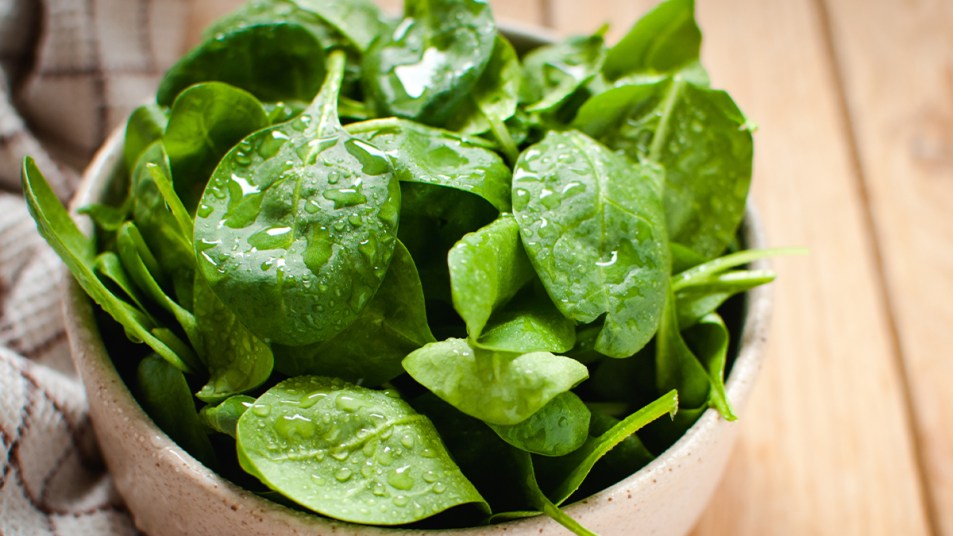Research Shows Eating Spinach Promotes Healthy Gut Bacteria and Reduces Inflammation

Whether you sneak it into your pesto, sauté it in a pan with olive oil and garlic, or toss it in a salad full of walnuts and cranberries, spinach is a delicious addition to your diet. The leafy green is high in vitamins, minerals, and antioxidants, making it the perfect nutrient booster. It’s also an excellent source of fiber, which promotes a healthy digestive system.
But fiber isn’t the only reason that spinach can help out your digestive health. A recent study published in The ISME Journal found that dark greens, such as spinach, lettuce and scallions, promote the growth of beneficial bacteria in the gut. The reason? These vegetables naturally possess sulfoquinovose (SQ), a sulfur-containing sugar. Spinach in particular contains abundant amounts of SQ. When specialized bacteria in the gut break down this complex sugar, they release hydrogen sulfide, a gas that is well-known for its rotten egg smell. In other words, this might be the reason you feel gassy after eating leafy greens.
During the study, microbiologists from the University of Vienna and the University of Konstanz analyzed stool samples from eight vegetarian volunteers. In doing so, they identified the species E. rectale as the gut bacteria that breaks down SQ. Based on high levels of cellular activity after the SQ fermented, scientists determined that E. rectale used the complex sugar for growth. This implies that SQ promotes the growth of E. rectale in the gut and causes smelly gas.
The findings are important (and surprising) because previous studies showed high-fat dairy products and meat to be the primary sources of smelly gas. Meat and dairy contain methionine, which produces sulfur when broken down in the gut. Now, leafy greens can be added to the list of gas-producing foods. It’s important to remember that gas is normal. However, particular smelly gas might warrant a trip to the doctor.
Why is the breakdown of a sulfosugar significant? According to the researchers, hydrogen sulfide can have both a beneficial and a harmful effect on the body. In small doses, as in spinach, it acts as an antioxidant and can reduce inflammation in the gut. In high doses, however, it can deteriorate the mucosal barrier inside the gastrointestinal tract. High amounts of hydrogen sulfide are even linked to cancer, particularly colon and ovarian cancers.
Spinach is also high in oxalates, which are tiny molecules that bind to calcium and certain other minerals to form crystals. Unfortunately, a diet high in oxalates can lead to kidney stones and other health issues, including inflammation, a mineral imbalance in the body, urinary tract issues, and poor gut function.
This is not to say that you shouldn’t eat the leafy vegetable. It promotes the development of healthy gut bacteria, as pointed out by Johns Hopkins Medicine. Plus, the USDA reports that one cup of spinach contains an impressive amount of folate, a natural form of vitamin B9 that helps the body break down complex carbohydrates. This further improves the digestive process.
Ultimately, understanding the balance of bacterial flora in your gut is important to your overall health. As explained by Harvard Health, a gut comprising healthy bacteria may help prevent or treat certain diseases. Two studies, one published in Genome Medicine and the other published in Arthritis and Rheumatology, have proved that an imbalance in gut bacteria may cause or predict rheumatoid arthritis. A healthy balance, in contrast, may prevent the disease. Another study published in the journal Science proves that certain strains of bacteria in the gut may prevent cancerous growths by improving the immune system’s ability to attack tumor cells.
So, should you eat more spinach, or less? Unless your doctor says otherwise, the vegetable should still have a place in your diet. As long as you don’t take a leaf out of Popeye’s book and eat huge quantities of it, you can reap the benefits of this leafy green.
















